+ Open data
Open data
- Basic information
Basic information
| Entry | Database: PDB / ID: 6glc | |||||||||||||||
|---|---|---|---|---|---|---|---|---|---|---|---|---|---|---|---|---|
| Title | Structure of phospho-Parkin bound to phospho-ubiquitin | |||||||||||||||
 Components Components |
| |||||||||||||||
 Keywords Keywords |  LIGASE / LIGASE /  ubiquitin / Parkin / phospho-ubiquitin / ubiquitin / Parkin / phospho-ubiquitin /  Parkinson's disease / Parkinson's disease /  E3 ligase / RBR domain / E3 ligase / RBR domain /  mitophagy mitophagy | |||||||||||||||
| Function / homology |  Function and homology information Function and homology informationpositive regulation of retrograde transport, endosome to Golgi / regulation of lipid transport / positive regulation of neurotransmitter uptake /  regulation protein catabolic process at presynapse / negative regulation of endoplasmic reticulum stress-induced neuron intrinsic apoptotic signaling pathway / negative regulation of primary amine oxidase activity / negative regulation of spontaneous neurotransmitter secretion / negative regulation of intralumenal vesicle formation / regulation of protein targeting to mitochondrion / negative regulation of glucokinase activity ...positive regulation of retrograde transport, endosome to Golgi / regulation of lipid transport / positive regulation of neurotransmitter uptake / regulation protein catabolic process at presynapse / negative regulation of endoplasmic reticulum stress-induced neuron intrinsic apoptotic signaling pathway / negative regulation of primary amine oxidase activity / negative regulation of spontaneous neurotransmitter secretion / negative regulation of intralumenal vesicle formation / regulation of protein targeting to mitochondrion / negative regulation of glucokinase activity ...positive regulation of retrograde transport, endosome to Golgi / regulation of lipid transport / positive regulation of neurotransmitter uptake /  regulation protein catabolic process at presynapse / negative regulation of endoplasmic reticulum stress-induced neuron intrinsic apoptotic signaling pathway / negative regulation of primary amine oxidase activity / negative regulation of spontaneous neurotransmitter secretion / negative regulation of intralumenal vesicle formation / regulation of protein targeting to mitochondrion / negative regulation of glucokinase activity / negative regulation of exosomal secretion / mitochondrion to lysosome vesicle-mediated transport / positive regulation of mitochondrial fusion / parkin-mediated stimulation of mitophagy in response to mitochondrial depolarization / protein K29-linked ubiquitination / regulation protein catabolic process at presynapse / negative regulation of endoplasmic reticulum stress-induced neuron intrinsic apoptotic signaling pathway / negative regulation of primary amine oxidase activity / negative regulation of spontaneous neurotransmitter secretion / negative regulation of intralumenal vesicle formation / regulation of protein targeting to mitochondrion / negative regulation of glucokinase activity / negative regulation of exosomal secretion / mitochondrion to lysosome vesicle-mediated transport / positive regulation of mitochondrial fusion / parkin-mediated stimulation of mitophagy in response to mitochondrial depolarization / protein K29-linked ubiquitination /  Lewy body / protein K27-linked ubiquitination / Parkin-FBXW7-Cul1 ubiquitin ligase complex / free ubiquitin chain polymerization / negative regulation of actin filament bundle assembly / regulation of synaptic vesicle transport / negative regulation of mitochondrial fusion / RBR-type E3 ubiquitin transferase / positive regulation of mitophagy in response to mitochondrial depolarization / positive regulation of protein linear polyubiquitination / Lewy body / protein K27-linked ubiquitination / Parkin-FBXW7-Cul1 ubiquitin ligase complex / free ubiquitin chain polymerization / negative regulation of actin filament bundle assembly / regulation of synaptic vesicle transport / negative regulation of mitochondrial fusion / RBR-type E3 ubiquitin transferase / positive regulation of mitophagy in response to mitochondrial depolarization / positive regulation of protein linear polyubiquitination /  F-box domain binding / negative regulation by host of viral genome replication / dopaminergic synapse / positive regulation of mitophagy / cellular response to toxic substance / regulation of dopamine metabolic process / regulation of necroptotic process / regulation of cellular response to oxidative stress / negative regulation of intrinsic apoptotic signaling pathway by p53 class mediator / protein K6-linked ubiquitination / autophagy of mitochondrion / positive regulation of dendrite extension / norepinephrine metabolic process / positive regulation of proteasomal protein catabolic process / protein localization to mitochondrion / negative regulation of oxidative stress-induced neuron intrinsic apoptotic signaling pathway / positive regulation of protein localization to membrane / negative regulation of JNK cascade / protein K11-linked ubiquitination / positive regulation of tumor necrosis factor-mediated signaling pathway / cellular response to dopamine / F-box domain binding / negative regulation by host of viral genome replication / dopaminergic synapse / positive regulation of mitophagy / cellular response to toxic substance / regulation of dopamine metabolic process / regulation of necroptotic process / regulation of cellular response to oxidative stress / negative regulation of intrinsic apoptotic signaling pathway by p53 class mediator / protein K6-linked ubiquitination / autophagy of mitochondrion / positive regulation of dendrite extension / norepinephrine metabolic process / positive regulation of proteasomal protein catabolic process / protein localization to mitochondrion / negative regulation of oxidative stress-induced neuron intrinsic apoptotic signaling pathway / positive regulation of protein localization to membrane / negative regulation of JNK cascade / protein K11-linked ubiquitination / positive regulation of tumor necrosis factor-mediated signaling pathway / cellular response to dopamine /  mitochondrial fission / mitochondrial fission /  aggresome assembly / ubiquitin conjugating enzyme binding / hypothalamus gonadotrophin-releasing hormone neuron development / regulation of canonical Wnt signaling pathway / regulation of mitochondrion organization / aggresome assembly / ubiquitin conjugating enzyme binding / hypothalamus gonadotrophin-releasing hormone neuron development / regulation of canonical Wnt signaling pathway / regulation of mitochondrion organization /  aggresome / female meiosis I / ERAD pathway / positive regulation of protein monoubiquitination / regulation of reactive oxygen species metabolic process / mitochondrion transport along microtubule / dopamine uptake involved in synaptic transmission / fat pad development / regulation of synaptic vesicle endocytosis / positive regulation of mitochondrial fission / dopamine metabolic process / regulation of dopamine secretion / female gonad development / ubiquitin-specific protease binding / seminiferous tubule development / aggresome / female meiosis I / ERAD pathway / positive regulation of protein monoubiquitination / regulation of reactive oxygen species metabolic process / mitochondrion transport along microtubule / dopamine uptake involved in synaptic transmission / fat pad development / regulation of synaptic vesicle endocytosis / positive regulation of mitochondrial fission / dopamine metabolic process / regulation of dopamine secretion / female gonad development / ubiquitin-specific protease binding / seminiferous tubule development /  startle response / male meiosis I / negative regulation of release of cytochrome c from mitochondria / protein monoubiquitination / positive regulation of intrinsic apoptotic signaling pathway by p53 class mediator / protein K63-linked ubiquitination / cullin family protein binding / startle response / male meiosis I / negative regulation of release of cytochrome c from mitochondria / protein monoubiquitination / positive regulation of intrinsic apoptotic signaling pathway by p53 class mediator / protein K63-linked ubiquitination / cullin family protein binding /  phospholipase binding / phospholipase binding /  mitophagy / regulation of protein ubiquitination / regulation of glucose metabolic process / negative regulation of insulin secretion / negative regulation of reactive oxygen species metabolic process / protein K48-linked ubiquitination / positive regulation of DNA binding / cellular response to unfolded protein / cellular response to manganese ion / protein autoubiquitination / regulation of proteasomal protein catabolic process / mitophagy / regulation of protein ubiquitination / regulation of glucose metabolic process / negative regulation of insulin secretion / negative regulation of reactive oxygen species metabolic process / protein K48-linked ubiquitination / positive regulation of DNA binding / cellular response to unfolded protein / cellular response to manganese ion / protein autoubiquitination / regulation of proteasomal protein catabolic process /  ubiquitin ligase complex / negative regulation of endoplasmic reticulum stress-induced intrinsic apoptotic signaling pathway / ubiquitin ligase complex / negative regulation of endoplasmic reticulum stress-induced intrinsic apoptotic signaling pathway /  energy homeostasis / regulation of neuron apoptotic process / Maturation of protein E / Maturation of protein E / ER Quality Control Compartment (ERQC) / Myoclonic epilepsy of Lafora / FLT3 signaling by CBL mutants / Prevention of phagosomal-lysosomal fusion / IRAK2 mediated activation of TAK1 complex / Alpha-protein kinase 1 signaling pathway / energy homeostasis / regulation of neuron apoptotic process / Maturation of protein E / Maturation of protein E / ER Quality Control Compartment (ERQC) / Myoclonic epilepsy of Lafora / FLT3 signaling by CBL mutants / Prevention of phagosomal-lysosomal fusion / IRAK2 mediated activation of TAK1 complex / Alpha-protein kinase 1 signaling pathway /  Glycogen synthesis / IRAK1 recruits IKK complex Glycogen synthesis / IRAK1 recruits IKK complexSimilarity search - Function | |||||||||||||||
| Biological species |   Homo sapiens (human) Homo sapiens (human) | |||||||||||||||
| Method |  X-RAY DIFFRACTION / X-RAY DIFFRACTION /  SYNCHROTRON / SYNCHROTRON /  MOLECULAR REPLACEMENT / Resolution: 1.8 Å MOLECULAR REPLACEMENT / Resolution: 1.8 Å | |||||||||||||||
 Authors Authors | Gladkova, C. / Maslen, S.L. / Skehel, J.M. / Komander, D. | |||||||||||||||
| Funding support |  United Kingdom, 4items United Kingdom, 4items
| |||||||||||||||
 Citation Citation |  Journal: Nature / Year: 2018 Journal: Nature / Year: 2018Title: Mechanism of parkin activation by PINK1. Authors: Gladkova, C. / Maslen, S.L. / Skehel, J.M. / Komander, D. | |||||||||||||||
| History |
|
- Structure visualization
Structure visualization
| Structure viewer | Molecule:  Molmil Molmil Jmol/JSmol Jmol/JSmol |
|---|
- Downloads & links
Downloads & links
- Download
Download
| PDBx/mmCIF format |  6glc.cif.gz 6glc.cif.gz | 181.4 KB | Display |  PDBx/mmCIF format PDBx/mmCIF format |
|---|---|---|---|---|
| PDB format |  pdb6glc.ent.gz pdb6glc.ent.gz | 140.9 KB | Display |  PDB format PDB format |
| PDBx/mmJSON format |  6glc.json.gz 6glc.json.gz | Tree view |  PDBx/mmJSON format PDBx/mmJSON format | |
| Others |  Other downloads Other downloads |
-Validation report
| Arichive directory |  https://data.pdbj.org/pub/pdb/validation_reports/gl/6glc https://data.pdbj.org/pub/pdb/validation_reports/gl/6glc ftp://data.pdbj.org/pub/pdb/validation_reports/gl/6glc ftp://data.pdbj.org/pub/pdb/validation_reports/gl/6glc | HTTPS FTP |
|---|
-Related structure data
- Links
Links
- Assembly
Assembly
| Deposited unit | 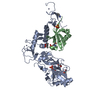
| ||||||||||||
|---|---|---|---|---|---|---|---|---|---|---|---|---|---|
| 1 |
| ||||||||||||
| Unit cell |
| ||||||||||||
| Components on special symmetry positions |
|
- Components
Components
-Protein , 2 types, 2 molecules AB
| #1: Protein | Mass: 43008.551 Da / Num. of mol.: 1 Source method: isolated from a genetically manipulated source Source: (gene. exp.)   Homo sapiens (human) / Gene: PRKN, PARK2 / Production host: Homo sapiens (human) / Gene: PRKN, PARK2 / Production host:   Escherichia coli (E. coli) Escherichia coli (E. coli)References: UniProt: O60260, RBR-type E3 ubiquitin transferase |
|---|---|
| #2: Protein | Mass: 8640.854 Da / Num. of mol.: 1 Source method: isolated from a genetically manipulated source Source: (gene. exp.)   Homo sapiens (human) / Gene: UBB / Production host: Homo sapiens (human) / Gene: UBB / Production host:   Escherichia coli (E. coli) / References: UniProt: P0CG47 Escherichia coli (E. coli) / References: UniProt: P0CG47 |
-Non-polymers , 5 types, 176 molecules 

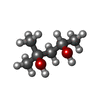






| #3: Chemical | ChemComp-ZN / #4: Chemical |  Glycerol Glycerol#5: Chemical | ChemComp-MPD / ( |  2-Methyl-2,4-pentanediol 2-Methyl-2,4-pentanediol#6: Chemical | ChemComp-SO4 / |  Sulfate Sulfate#7: Water | ChemComp-HOH / |  Water Water |
|---|
-Experimental details
-Experiment
| Experiment | Method:  X-RAY DIFFRACTION / Number of used crystals: 1 X-RAY DIFFRACTION / Number of used crystals: 1 |
|---|
- Sample preparation
Sample preparation
| Crystal | Density Matthews: 2.32 Å3/Da / Density % sol: 40.56 % |
|---|---|
Crystal grow | Temperature: 291 K / Method: vapor diffusion, hanging drop / pH: 7.5 Details: 12.5% (w/v) PEG 1000, 12.5% (w/v) PEG 3350, 12.5% (v/v) MPD, 0.03 M of each sodium nitrate, disodium hydrogen phosphate, ammonium sulphate, 0.1 M MOPS/HEPES-Na (pH 7.5) |
-Data collection
| Diffraction | Mean temperature: 100 K |
|---|---|
| Diffraction source | Source:  SYNCHROTRON / Site: SYNCHROTRON / Site:  Diamond Diamond  / Beamline: I24 / Wavelength: 0.96859 Å / Beamline: I24 / Wavelength: 0.96859 Å |
| Detector | Type: DECTRIS PILATUS3 6M / Detector: PIXEL / Date: Apr 22, 2018 |
| Radiation | Protocol: SINGLE WAVELENGTH / Monochromatic (M) / Laue (L): M / Scattering type: x-ray |
| Radiation wavelength | Wavelength : 0.96859 Å / Relative weight: 1 : 0.96859 Å / Relative weight: 1 |
| Reflection | Resolution: 1.8→72.69 Å / Num. obs: 40324 / % possible obs: 100 % / Redundancy: 6.7 % / Rmerge(I) obs: 0.065 / Net I/σ(I): 13.8 |
| Reflection shell | Resolution: 1.8→1.84 Å / Rmerge(I) obs: 0.773 / Mean I/σ(I) obs: 2.4 / Num. unique obs: 2339 / % possible all: 99.3 |
- Processing
Processing
| Software |
| |||||||||||||||||||||||||||||||||||||||||||||||||||||||||||||||||||||||||||||||||||||||||||||||||||||||||
|---|---|---|---|---|---|---|---|---|---|---|---|---|---|---|---|---|---|---|---|---|---|---|---|---|---|---|---|---|---|---|---|---|---|---|---|---|---|---|---|---|---|---|---|---|---|---|---|---|---|---|---|---|---|---|---|---|---|---|---|---|---|---|---|---|---|---|---|---|---|---|---|---|---|---|---|---|---|---|---|---|---|---|---|---|---|---|---|---|---|---|---|---|---|---|---|---|---|---|---|---|---|---|---|---|---|---|
| Refinement | Method to determine structure : :  MOLECULAR REPLACEMENT MOLECULAR REPLACEMENTStarting model: 5n2w, 5c1z Resolution: 1.8→59.786 Å / SU ML: 0.18 / Cross valid method: FREE R-VALUE / σ(F): 1.46 / Phase error: 22.14
| |||||||||||||||||||||||||||||||||||||||||||||||||||||||||||||||||||||||||||||||||||||||||||||||||||||||||
| Solvent computation | Shrinkage radii: 0.9 Å / VDW probe radii: 1.11 Å | |||||||||||||||||||||||||||||||||||||||||||||||||||||||||||||||||||||||||||||||||||||||||||||||||||||||||
| Refinement step | Cycle: LAST / Resolution: 1.8→59.786 Å
| |||||||||||||||||||||||||||||||||||||||||||||||||||||||||||||||||||||||||||||||||||||||||||||||||||||||||
| Refine LS restraints |
| |||||||||||||||||||||||||||||||||||||||||||||||||||||||||||||||||||||||||||||||||||||||||||||||||||||||||
| LS refinement shell |
| |||||||||||||||||||||||||||||||||||||||||||||||||||||||||||||||||||||||||||||||||||||||||||||||||||||||||
| Refinement TLS params. | Method: refined / Origin x: -6.6329 Å / Origin y: -26.8647 Å / Origin z: -16.2338 Å
| |||||||||||||||||||||||||||||||||||||||||||||||||||||||||||||||||||||||||||||||||||||||||||||||||||||||||
| Refinement TLS group | Selection details: all |
 Movie
Movie Controller
Controller



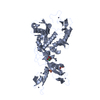

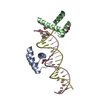


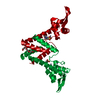
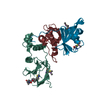
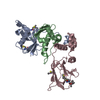
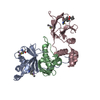
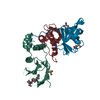
 PDBj
PDBj




















